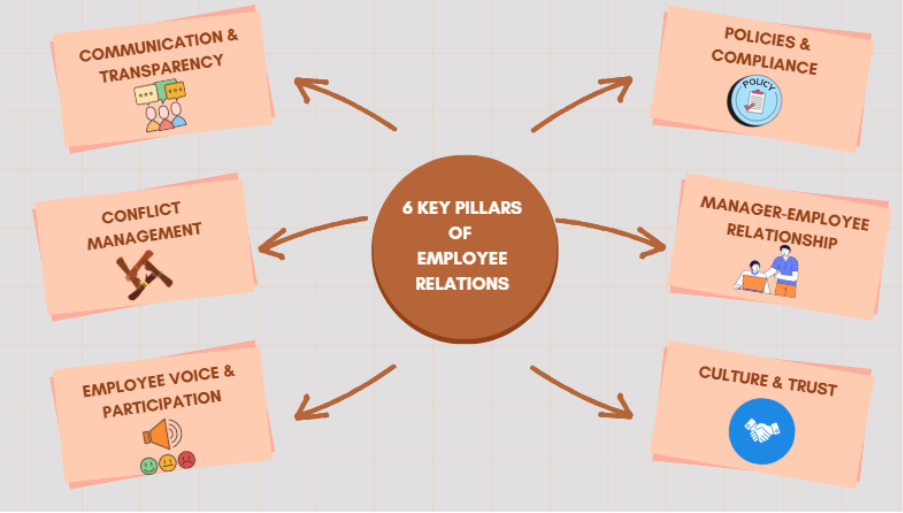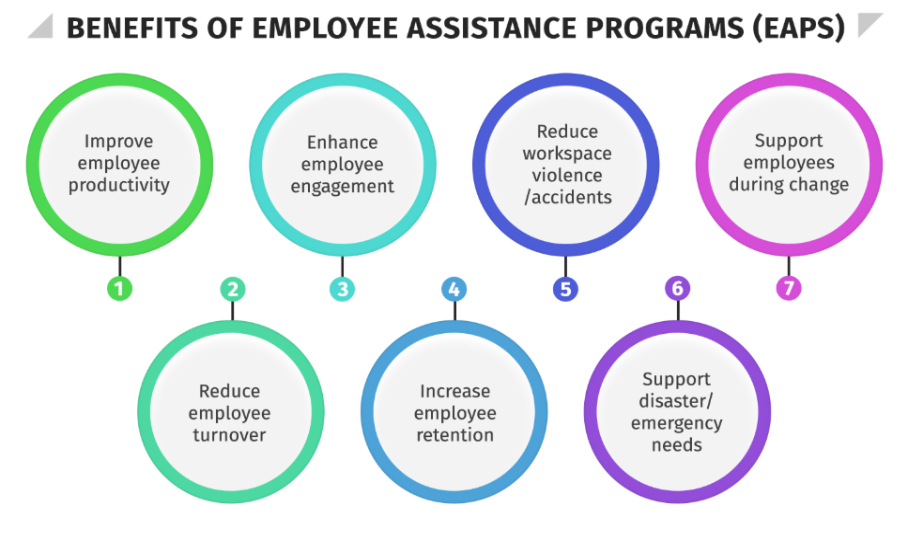Work Related Concerns
Building Strong Employee Relations: Meaning, Strategies, and Best Practices

.png)
Written by
Aarohi Parakh,
Psychologist and Content Writer

Reviewed by
Sanjana Sivaram,
Psychologist and Clinical Content Head

Introduction: Why Employee Relations Matter More Than Ever
The workplace of today is changing rapidly, from remote and hybrid work models to more diverse, multigenerational teams. Employee relations is now more than just a Human Resources (HR) function in such a setting; it is the cornerstone of a happy, engaged, and healthy workforce.
The term "employee relations" describes how organisations establish and maintain positive relationships with their team members via fairness, openness, and trust.
This article will examine:
- The significance and relevance of employee relations
- HR leaders' best practices, strategies, and examples
- How to improve relations between employees in Indian workplaces, and
- The role of Employee Assistance Programmes (EAPs), such as those provided by 1to1help
What Does Employee Relations Mean?
Employee relations (ER) involves the continuous process of building healthy working relationships between employer and employees. In order to guarantee both employee satisfaction and organisational success, it focusses on encouraging respect for one another, equitable treatment, open communication, and teamwork.
It is not the same as traditional industrial relations, which focussed mostly on resolving conflicts between trade unions and employers. HR's contemporary approach to employee relations prioritises trust, engagement, and well-being over just compliance.
Employee relations in Human Resources (HR) serves as a link between employees' needs and business objectives.
For instance, maintaining adherence to laws such as the Industrial Disputes Act, 1947, state-wise Shops and Establishment Acts, and Prevention of Sexual Harassment of Women at Workplace (Protection, Prohibition and Redressal), POSH Act, 2013. is a common aspect of employee relations in India.

The Evolution of Employee Relations
Transactional employee relations have given way to transformational ones.
Then: Pay, attendance, and compliance were the primary focus. Currently: Focussed on organisational culture, psychological safety, and communication.
Employee relations management is now a strategic HR priority due to the global workforce shift brought about by AI, automation, hybrid work, and growing mental health awareness.
HR managers are now expected to create work environments where staff members feel supported, appreciated, and heard.

Key Components of Employee Relations
Six essential pillars that support good employee relations:
a. Communication & Transparency
Open, honest communication builds trust. HR should promote town halls, anonymous feedback channels, and regular updates.
b. Conflict Management
Structured grievance redressal procedures and skilled mediators to settle conflicts quickly are essential components of an effective employee relations policy.
c. Employee Voice & Participation
Give workers a voice in workplace decisions by empowering them through forums, surveys, and "listening circles."
d. Policies & Compliance
In accordance with labour laws, a transparent, equitable employee relations policy guarantees uniformity in treatment, disciplinary measures, and dispute resolution.
e. Manager–Employee Relationship
In employee relations strategy, line managers are essential. Being the initial point of contact, they influence daily interactions and experiences.
f. Culture & Trust
Fairness, inclusion, and accountability are the foundations of trust. Employees can speak freely in a culture that prioritises psychological safety.

Importance of Employee Relations in HR
Positive employee relations enhance both people and performance.
The following benefits result from HR's investment in positive workplace relationships:
- Employee engagement and retention — When workers feel valued, they stay in the job longer.
- Productivity and morale — Open communication increases drive and motivation.
- Employer branding — Top talent is drawn to companies with a strong ER.
- Reduced conflicts and absenteeism — Early intervention stops escalation.
Studies show that businesses with high-trust cultures are 50% more productive and experience 74% less stress than those with low trust.
By offering private emotional and mental health support, building trust between staff members and the company, and encouraging general well-being that raises engagement and productivity, employee assistance programmes (EAPs) like 1to1help further improve employee relations.
Employee Relations Strategy: How HR Can Build a Healthy Workplace
A good employee relations strategy will maintain a balance between what employers want (productivity and performance) and what employees need (recognition and acknowledgement). HR leaders can use the following five-step framework:
1. Listen and Measure Employee Sentiment
Conduct regular surveys, one-on-one meetings, and pulse checks to gauge employees' feelings. Encourage anonymity to improve honesty.
Example: To measure stress and morale, a Bengaluru-based IT services company launched a quarterly survey called "Employee Pulse 360." HR improved manager check-ins and redesigned workloads based on the results.
2. Build a Culture of Feedback and Recognition
Encourage two-way feedback; staff should be able to express their opinions freely about management and work processes. Programmes for recognition and team-building activities create a strong sense of belonging and collaboration among employees.

Example: A Pune-based manufacturing company started a peer appreciation programme called "Kudos Connect," which enables staff members to acknowledge one another on the corporate intranet publicly. The programme improved morale and bolstered teamwork.
3. Train Managers in Empathy and Conflict Resolution
Give managers the employee relations know-how to manage challenging discussions, understand emotions, and align behaviour with company values.
Example: An emotional intelligence and conflict resolution-focused leadership development series called "Lead with Empathy" was implemented by a healthcare organisation in Mumbai. Grievances decreased by 30% after six months.

4. Establish Clear, Fair Policies
Transparency in policies increases trust. All employees should be aware of grievance procedures and escalation routes.
Example: A Delhi NCR consumer goods company established a digital policy hub called "Know Your Rights," where employees can easily access information on HR regulations and file complaints. This increased transparency and reduced policy ambiguity.
5. Invest in Wellbeing and Psychological Safety
Partner with Employee Assistance Programme (EAP) service providers like 1to1help, whose employee mental health-focused initiatives can help HR teams in proactively addressing relationship issues, stress, and burnout.
Example: In collaboration with an EAP service provider, a retail company introduced "Thrive@Work," which provides manager mental health workshops and private counselling. Employee satisfaction increased, and absenteeism decreased in six months.

Examples of Good Employee Relations Practices
Here are a few employee relations examples HR leaders can learn from:
- Transparent feedback systems: Employees are encouraged to provide managers with direct feedback through frequent and transparent performance discussions. Organisations can strengthen trust at all levels and detect problems early through continuous feedback loops.
- Manager empathy training: Leadership development programmes that focus on empathy, listening skills, and emotional intelligence equip managers to handle sensitive conversations and support employee well-being.
- Open-door policies: Promoting open communication between managers and team members creates a transparent and psychologically safe environment where workers feel free to express their thoughts and worries.
- Recognition programmes: Peer-to-peer appreciation tools, digital badges, and "Thank You" boards are examples of recognition systems that improve team morale and strengthen a sense of purpose and belonging.
- Cross-functional collaboration: Initiatives such as innovation days, hackathons, and team challenges facilitate cross-departmental partnership, knowledge sharing, and creativity.
💡 In the Indian workplace, leading organisations are incorporating these practices through collaborative innovation events, empathy-based leadership training, and digital feedback platforms, resulting in healthier, more connected, and more resilient workplaces.
Employee Relations Metrics and Measurement
You can’t improve what you don’t measure. Monitoring results enables HR departments to determine what is effective, identify new problems, and show the true worth of their employee relations programmes. It's critical to integrate qualitative insights with quantitative measurements to obtain a complete picture.
Some of the Key Metrics that HR departments track are presented below:
- Employee satisfaction and engagement scores: HR can determine how engaged and motivated employees feel with the use of eNPS (Employee Net Promoter Score) and regular engagement surveys. A consistent improvement in these scores indicates stronger alignment, trust, and morale.
- Grievances raised and resolved: Keeping track of the number, type, and time it takes to resolve grievances shows how well HR handles employee concerns and whether workers feel comfortable raising them. A clear grievance procedure and a decrease in recurrent cases are signs of progress.
- Retention and absenteeism rates: Strong employee relations and a supportive culture are frequently indicated by high retention and low unscheduled absenteeism. Finding hidden stressors or management gaps can be facilitated by examining absenteeism and exit trends.
- Participation in feedback channels: The general trust climate of the company can be determined by monitoring the number of employees who complete surveys, suggestion boxes, or online feedback tools. High participation indicates that workers believe their ideas lead to change.
- Frequency of pulse surveys: HR can track changing sentiment and respond promptly with brief, frequent pulse checks. Early warning indicators of burnout, disengagement, or cultural misalignment can be found by comparing responses over time.
Qualitative Insights:
Qualitative feedback explains the reasons behind the numbers, while the numbers themselves only tell a part of the story.
- Employees can freely discuss their experiences in focus groups, which gives HR a better understanding of workplace dynamics.
- Stay interviews, which are done with current, motivated employees, provide insight into what keeps people on board and what could drive them to quit.
- Exit interviews offer insightful commentary on communication, leadership, and organisational culture.
When combined, these discussions can reveal hidden problems with trust, poor communication, or inconsistent policies that may go unnoticed by metrics alone.
💡 Tip: By integrating data and discussion, a balanced measurement approach enables HR to assess employee relations initiatives and make ongoing improvements to create a more responsive, healthy workplace.
Common Challenges in Employee Relations
Roadblocks are faced in even well-established organisations. The following are common challenges and how to address them:

Employee Relations in the Indian Context
In India, employee relations are shaped by a unique blend of structural, cultural, and legal factors. HR directors must strike a balance between compliance and compassion, modifying policies to accommodate their workforce's needs and the legal environment.
Legal backdrop:
India’s changing labour laws and workplace regulations have a significant impact on the country’s employee relations environment. To maintain equity, compliance, and employee protection, HR professionals need to stay up to date on essential laws.
- Industrial Relations Code, 2020: Combines laws about dispute resolution, grievance redressal, and trade unions. It aims to strike a balance between employee job security and employer flexibility by streamlining employer-employee negotiations and introducing more transparent processes for layoffs, retrenchments, and strikes.
- POSH Act, 2013 (Prevention of Sexual Harassment): It requires all organisations to establish an Internal Committee (IC), provide a safe and courteous work environment, and regularly raise employee awareness through awareness campaigns. It is essential to establish psychological safety and trust.
- Shops and Establishment Acts: Includes laws unique to each state that control pay, holidays, working hours, and working conditions in businesses. In both small and large companies, compliance guarantees equitable treatment and guards against exploitation.
- Labour Codes on Wages, Social Security, and Occupational Safety: By guaranteeing fair wages, extending social security benefits like PF and maternity leave to more workers (including gig workers), and enhancing safety and working conditions for all workers, including contract and migrant workers, India's new labour codes unify outdated laws.
Cultural dynamics:
Respect for authority, hierarchical communication, and diverse generational values are common in Indian workplaces. Respect and transparency must be balanced in order to foster trust.
Modern shifts:
Employee relations management is evolving in response to startups, gig workers, and hybrid teams. HR leaders of today must blend local awareness with international best practices.
💡 In summary, creating equitable and forward-thinking workplaces in India requires striking a balance between legal compliance, cultural sensitivity, and flexible HR procedures.
The Role of Employee Assistance Programmes (EAPs) in Strengthening Relations
Best practices for employee relations now place a strong emphasis on mental and emotional health.
Employee Assistance Programmes (EAPs) are essential for:
- Promoting emotional stability and mental health;
- Providing private counselling
- Helping managers deal with delicate situations;
- Increasing trust and communication at work

EAPs at 1to1help are customised to meet the particular needs of Indian organisations. Services range from employee counselling to manager enablement, which enable HR teams to create workplaces that are psychologically safe and driven by empathy.
Find out how your HR teams can improve overall employee wellbeing, resolve conflicts, and foster trust with the help of 1to1help's EAP and leadership programmes.
Future of Employee Relations: Trends for 2025 and Beyond
Data-driven, human-centered, and technology-enabled employee relations will be the norm in the future of employee relations.
Among the new developments are:
- AI-driven sentiment analysis that helps HR identify early indicators of disengagement.
- Psychological safety as a KPI: Assessing transparency and trust as performance metrics.
- Integration of mental health and ER: EAPs becoming part of core HR strategy.
- Continuous manager coaching: Giving leaders the ability to empathise and provide constructive feedback.
- Flexible work expectations: striking a balance between responsibility, independence, and community.
FAQs
1. What is the main role of employee relations?
To encourage open communication, settle disputes, and foster trust between employers and employees.
2. What are examples of employee relations activities?
Manager training, wellness programmes, feedback sessions, and recognition programmes.
3. How is employee relations different from HR?
While employee relations is primarily concerned with relationship management and workplace harmony, human resources is the more general function that covers hiring, payroll, and performance.
4. What are employee relations issues?
Communication breakdowns, mistrust, discrimination, and disputes between teams or managers are typical problems.
5. How can HR improve employee relations?
Through encouraging openness, compassionate leadership, robust regulations, and wellness initiatives like EAPs.
6. What are employee relations laws in India?
The Shops and Establishments Acts, the POSH Act, and the Industrial Relations Code are important laws in India governing employee relations.
Conclusion
Organisations flourish when they have strong employee relations because they foster work environments where staff members feel appreciated, heard, and inspired.
Building these relationships requires HR leaders in India to strike a balance between human connection and business success, structure and empathy, and compliance and compassion.
Support and listening are the foundation of good employee relations.
Discover how the leadership and wellbeing initiatives from 1to1help can support the growth of your teams through proactive communication, trust, and care.
Further Reading
- Learn how empathetic leadership creates trust and strengthens team culture. Please read our blog on Empathetic Leadership to explore practical ways managers can lead with compassion.
- Discover what sets effective leaders apart in today’s workplace. Our blog on Successful vs Effective Leader shares actionable strategies for building influence and credibility.
- High turnover can signal deeper engagement issues. Check out our insights on Employee Attrition to understand the causes and implement long-term retention strategies.
- Burnout affects both performance and morale. Visit our blog on Preventing Burnout to learn how leaders and HR can build resilience and balance in the workplace.
References
- Britannica. (n.d.). Industrial relations. In Encyclopedia Britannica. https://www.britannica.com/money/industrial-relations
- Government of India. (1947). The Industrial Disputes Act, 1947 (Act No. 14 of 1947). Ministry of Labour & Employment. https://labour.gov.in/sites/default/files/a1947-14_1.pdf
- Government of India. (2013). The Sexual Harassment of Women at Workplace (Prevention, Prohibition and Redressal) Act, 2013 (POSH Act). https://www.indiacode.nic.in/bitstream/123456789/2104/1/A2013-14.pdf
- greytHR. (n.d.). Shops and Establishments Act (India). https://www.greythr.com/wiki/acts/shops-and-establishments-act-india/
- American Psychological Association. (n.d.). Psychological safety in the workplace. https://www.apa.org/topics/healthy-workplaces/psychological-safety
- Verywell Mind. (n.d.). Stress and health. https://www.verywellmind.com/stress-and-health-3145086
- Psychology Today. (n.d.). Burnout. https://www.psychologytoday.com/us/basics/burnout
- Talkspace. (n.d.). Relationship problems: Causes, management, and therapy. https://www.talkspace.com/blog/relationship-problems/
- IdeaScale. (n.d.). What is a focus group? https://ideascale.com/blog/what-is-a-focus-group/
- AIHR. (n.d.). Stay interview questions: The complete guide. https://www.aihr.com/blog/stay-interview-questions/
- AIHR. (n.d.). Employee relations: The complete guide. https://www.aihr.com/blog/employee-relations/
- CIPD. (n.d.). Employee relations factsheet. https://www.cipd.org/en/knowledge/factsheets/relations-employees-factsheet/
- BambooHR. (n.d.). Employee relations definition. https://www.bamboohr.com/resources/hr-glossary/employee-relations
- HiBob. (n.d.). Employee relations glossary. https://www.hibob.com/hr-glossary/employee-relations/
- PeopleHR. (n.d.). Exit interviews: Purpose and best practices. https://www.peoplehr.com/en-gb/resources/blog/exit-interviews/
- Coursera. (n.d.). What is employee relations? https://www.coursera.org/in/articles/employee-relations
- HR Acuity. (2023, January 30). Human resources vs. employee relations: The key differences to note. https://www.hracuity.com/blog/human-resources-vs-employee-relations-the-key-differences-to-note/
- Miles, S. (2023, August 25). Trust: The glue piecing together out-performance. Forbes. https://www.forbes.com/sites/stephenmiles/2023/08/25/trust-the-glue-piecing-together-out-performance/
- Netish, S. (2023, September 15). The role of listening circles in leadership communication. LinkedIn Pulse. https://www.linkedin.com/pulse/role-listening-circles-leadership-communication-netish-sharma-oparc/
- Damilare, O. (2024, February 12). Conflict resolution using the interest-based relational approach. LinkedIn Pulse. https://www.linkedin.com/pulse/conflict-resolution-using-interest-based-relational-damilare/
- AIHR. (2024, May 6). Diversity, equity, inclusion, and belonging (DEIB): The complete guide. https://www.aihr.com/blog/diversity-equity-inclusion-belonging-deib/
- Forbes Advisor. (2024, June 20). What is employee relations? Definition and examples. https://www.forbes.com/advisor/business/what-is-employee-relations/










